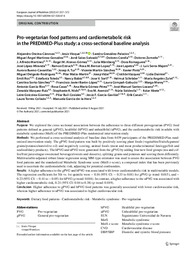Título :
Pro‑vegetarian food patterns and cardiometabolic risk in the PREDIMED‑Plus study: a cross‑sectional baseline analysis |
Autor :
Oncina Canovas, Alejandro 
Vioque, Jesús
González Palacios, Sandra 
Martínez González, Miguel Ángel 
Salas-Salvadó, Jordi 
Corella, Dolores
Zomeño, M. Dolores 
Martínez, J. Alfredo
Alonso-Gómez, Ángel 
Wärnberg, Julia
Romaguera, Dora 
López-Miranda, José
Estruch, Ramón
Bernal-López, Rosa M.
Lapetra, José
Serra-Majem, J. Luis
Bueno Cavanillas, Aurora 
Tur, Josep A.
Martín-Sánchez, Vicente
Pintó, Xavier
Delgado-Rodríguez, Miguel
Matía-Martín, Pilar
Vidal, Josep
Vázquez, Clotilde 
Daimiel, Lidia
Ros, Emili
Toledo, Estefanía
Bablo, Nancy
Sorli, José V.
Schöder, Helmut
Zulet, M. Angeles 
Sorto-Sánchez, Carolina
Barón López, Francisco Javier 
Compañ Gabucio, Laura M 
Morey, Marga
García-Ríos, Antonio
Casas, Rosa 
Gómez Pérez, Ana María 
Santos Lozano, José Manuel 
Vazquez-Ruiz, Zenaida 
Nishi, Stephanie 
Asensio, Eva M.
Soldevilla, Nuria
Abete, Itziar 
Goikolea-Güemez, Leire
Buil-Cosiales, Pilar 
García-Gavilán, Jesús F.
Canals, Erik
Torres-Collado, Laura 
Garcia de la Hera, Manuela  |
Editor :
Springer |
Departamento:
Departamentos de la UMH::Salud Pública, Historia de la Ciencia y Ginecología |
Fecha de publicación:
2021-08-09 |
URI :
https://hdl.handle.net/11000/30764 |
Resumen :
Purpose We explored the cross-sectional association between the adherence to three different provegetarian (PVG) food patterns defined as general (gPVG), healthful (hPVG) and unhealthful (uPVG), and the cardiometabolic risk in adults with metabolic syndrome (MetS) of the PREDIMED-Plus randomized intervention study. Methods We performed a cross-sectional analysis of baseline data from 6439 participants of the PREDIMED-Plus randomized intervention study. The gPVG food pattern was built by positively scoring plant foods (vegetables/fruits/legumes/ grains/potatoes/nuts/olive oil) and negatively scoring, animal foods (meat and meat products/animal fats/eggs/fish and seafood/dairy products). The hPVG and uPVG were generated from the gPVG by adding four new food groups (tea and coffee/ fruit juices/sugar-sweetened everages/sweets and desserts), splitting grains and potatoes and scoring them differently. Multivariable-adjusted robust linear regression using MM-type estimator was used to assess the association between PVG food patterns and the standardized Metabolic Syndrome score (MetS z-score), a composed index that has been previously used to ascertain the cardiometabolic risk, adjusting for potential confounders. Results A higher adherence to the gPVG and hPVG was associated with lower cardiometabolic risk in multivariable models. The regression coefficients for 5th vs. 1st quintile were − 0.16 (95% CI: − 0.33 to 0.01) for gPVG (p trend: 0.015), and −
0.23 (95% CI: − 0.41 to − 0.05) for hPVG (p trend: 0.016). In contrast, a higher adherence to the uPVG was associated with higher cardiometabolic risk, 0.21 (95% CI: 0.04 to 0.38) (p trend: 0.019). Conclusion Higher adherence to gPVG and hPVG food patterns was generally associated with lower cardiovascular risk,
whereas higher adherence to uPVG was associated to higher cardiovascular risk.
|
Palabras clave/Materias:
Dietary food patterns
Cardiometabolic risk
Metabolic syndrome
Pro-vegetarian |
Tipo de documento :
info:eu-repo/semantics/article |
Derechos de acceso:
info:eu-repo/semantics/openAccess
Attribution-NonCommercial-NoDerivatives 4.0 Internacional |
DOI :
https://doi.org/10.1007/s00394-021-02647-4 |
Publicado en:
European Journal of Nutrition (2022) 61:357-372 |
Aparece en las colecciones:
Artículos Salud Pública, Historia de la Ciencia y Ginecología
|

 La licencia se describe como: Atribución-NonComercial-NoDerivada 4.0 Internacional.
La licencia se describe como: Atribución-NonComercial-NoDerivada 4.0 Internacional.
.png)